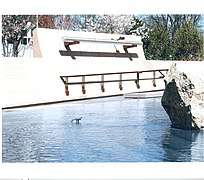Paul Matisse
Paul Matisse (born 1933) is an artist and inventor known for his public art installations, many of which are interactive. Matisse also invented the Kalliroscope.
Early life and education
Paul Matisse is the stepson of artist Marcel Duchamp and grandson of French painter Henri Matisse. Henri Matisse's son, Pierre Matisse, was Paul's father.[1]
In 1954 Matisse graduated from Harvard University,[1] where he once lived in Eliot House.
Matisse studied at Harvard's Graduate School of Design, and worked briefly with Buckminster Fuller.[2]
Artistic career
Matisse worked in product development for Arthur D. Little.[2] In 1962 he set off on his own, inventing (1966), patenting (1968), and ultimately manufacturing Kalliroscopes, which can display the complex and otherwise-invisible flow of liquids.[3]
After the death of his stepfather Marcel Duchamp in 1968, Matisse worked with his widowed stepmother Alexina "Teeny" Duchamp and curator Anne d'Harnoncourt to implement the posthumous installation of Duchamp's now-iconic artwork Étant donnés at the Philadelphia Museum of Art.[4]
From 1977 to 1979 he helped install a full-scale "mobile" sculpture by Alexander Calder (who had died suddenly in 1976) for the National Gallery of Art in Washington, DC. The original design in steel was too heavy for display, so a lighter-weight version made with aluminum honeycomb supported from steel bars was fabricated and installed instead. Before his death, Calder had asked Matisse for his assistance in performing these tasks.[5]
Thereafter, Matisse began his own public art career.
Personal life
Matisse currently resides with his wife Mimi and has a workshop and gallery in a former Baptist church in Groton, Massachusetts.[1][2] His daughter Sophie Matisse is a painter in New York. His son, Alex Matisse, is a pottery artist and founder of East Fork Pottery in North Carolina. His granddaughter is actress Gaïa Jacquet-Matisse.
Selected public artworks
 Forest Bells (1997)
Forest Bells (1997) Charlestown Bells (2000)
Charlestown Bells (2000) National Japanese American Memorial Bell (2001)
National Japanese American Memorial Bell (2001)
- Musical Fence (1980) – interactive musical sculpture once located in Cambridge, Massachusetts, and now housed at the DeCordova Museum in Lincoln, Massachusetts. Another version is at the Montshire Museum of Science in Vermont.
- Kendall Band (1987) – interactive musical sculpture in the MBTA's Kendall/MIT subway station in Cambridge, Massachusetts
- Forest Bells (1997)] – six vertical aluminum bells hanging from the limbs of oak trees on Groton Conservation Trust property in Groton, Massachusetts[6]
- Charlestown Bells (2000) – interactive musical sculpture on the Charles River Dam between downtown Boston, Massachusetts and the Boston neighborhood of Charlestown
- Memorial Bell (2001) – at the National Japanese-American Memorial to Patriotism in Washington, DC
References
- Reed, Christopher (1 May 2002). "Pure Fabrications". Harvard Magazine. Harvard University. Retrieved 2019-05-02.
- "Bio". Paul Matisse. Retrieved 2019-05-02.
- "History". Paul Matisse. Retrieved 2019-05-02.
- "Philadelphia Museum of Art - Exhibitions - Marcel Duchamp: Étant donnés". Philadelphia Museum of Art - Exhibitions. Philadelphia Museum of Art. Retrieved 2019-07-06.
- "Calder Mobile". Paul Matisse. Retrieved 2019-05-02.
- "Forest Bells". Paul Matisse. Retrieved 2019-05-02.